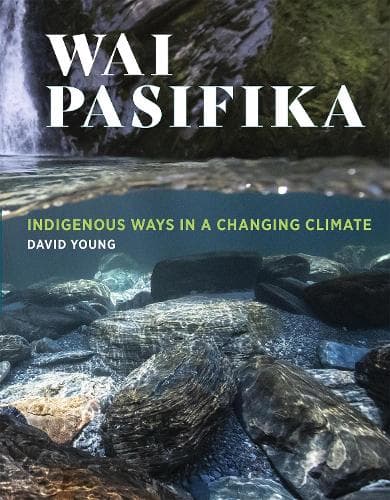Review: Wai Pasifika: Indigenous Ways in a Changing Climate
Reviewed by Laura Goodall
In Wai Pasifika: Indigenous Ways in a Changing Climate, environmental writer David Young shares a unique perspective on indigenous peoples’ relationship with freshwater, as seen through a Pākehā lens and shaped by three decades of relationships with indigenous knowledge holders.
As I scrolled through my Facebook feed one morning, I saw a post from my local council that stopped me in my tracks. It said, “Due to the recent extreme rainfall we have had to undertake an emergency discharge of sewage… Please avoid the stream”. My heart sank. The stream runs in front of my house and is home to many wild birds. Kaitiaki have also spent months cleaning it up, only to have their hard work undone by an act that could have been avoided.
As Young explains so well in Wai Pasifika, the way we think about and use water is perilously shortsighted and fragmentary: “The entire paradigm on which our increasingly uncivil civilisation teeters ignores the one word that indigenous people return to again and again: respect for life and life-giving systems on earth.”
When I was asked to review the book, I cautiously agreed. The irony is not lost on me: I’m a white person reviewing a book written by a white person about indigenous ways and I recognise how tired indigenous communities are of non-indigenous people writing about (often mistranslating and misrepresenting) their knowledge and practices instead of them.
But I was reassured by Young’s immediate statement that the book is “an exploration of the indigenous reflections and uses of water from the perspective of an Aotearoa New Zealand Pākehā.” The book’s purpose, rather, is to share with non-indigenous readers more helpful ways of thinking and acting in relation to our environment:
“It is not about becoming Māori or of any other indigenous culture. When these older, locally-informed world views are not discounted, they can anchor us into a deeper appreciation of place. With that can come a sense both of belonging and of responsibility and the abandonment of entitlement”.
In Wai Pasifika, Young discusses the different types of freshwater sources and systems across the Pacific, the history of how indigenous communities use water and how this changed when colonisers arrived, the problem with current trends in water management, the revitalisation of indigenous-led water and food management practices, and how climate change is forcing a rethink on our relationship with water and the wider natural world.
The book opened my eyes to a whole world of freshwater that I didn’t give much thought to before now, such as trees, groundwater, snow, fog and freshwater lenses (a layer of freshwater that sits on top of saltwater in coral atolls). As someone who grew up in a country with plentiful water that I took for granted, it was fascinating to read about Kiribati’s reliance on freshwater lenses, for example, and how the different islands of Hawai`i aren’t all lush forest and waterfalls, with the sieve-like lava making water more difficult to access than it appears. Young also talks about how these ‘hidden’ water systems can link events that do not seem connected, such as the recent forest fires in the Pacific Northwest affecting wild salmon stocks.
A highlight for me is the real sense of place felt when Young describes each locale, in which he vividly recounts his personal experiences of visiting these unique landscapes and waterscapes. Those who are yearning to go travelling will enjoy this armchair voyage, brought to life with stunning images by photographers Richard Sidey and Aliscia Young.
I was expecting lots of in-depth examples of contemporary indigenous-led research projects and practises woven throughout the book but that is not the case. It is not really until the second half of the book that Young focuses more on contemporary applications and moves away from frequently referring to indigenous knowledge and practices as ‘old’ or ‘traditional’ and science as ‘modern’ (indigenous knowledge is in fact continually updated and added to by successive generations in response to our changing world).
In addition, most of the historical sources Young refers to in the first half are written by colonisers such as missionaries and, through quoting them, he also inadvertently reinforces the “ecologically noble savage” stereotype, (a stereotype that idealises indigenous people living in perfect harmony with the environment), which I understand indigenous communities are trying to quell.
Overall, however, it is clear that Young has written this book with aroha and respect - which no doubt comes from his 30-year relationship with Whanganui iwi - and it is apparent that he has tried to source information directly from the knowledge holders themselves where possible.
For me, Wai Pasifika echoes Young’s decades-long journey in Te Ao Māori and how his thinking about indigenous ways of knowing, being and doing has evolved during time. Similarly, I hope that his book will help ignite a change in policymakers’ thinking towards a more holistic, long-term, sustainable and resilient way of living - as he summarises perfectly towards the end of the final chapter:
“Modern Portland is not yet reflecting its traditional First Nation history - just as there is not a predominant Polynesian culture in Hawai’i, Aotearoa or Rapanui. But…you still need those fundamentals of catchment, community and connection underpinned by indigenous knowledge, sound science and climate change mitigation. A change in consciousness is what’s needed: politics as we know it is simply not enough.”
Reviewed by Laura Goodall
